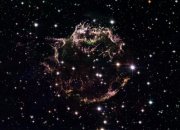
Worksheets and No Prep Teaching Resources
Reading Comprehension Worksheets
Space and Stars

Space and Stars
 Worksheets and No Prep Teaching Resources Reading Comprehension Worksheets Space and Stars |
 Space and Stars |
| edHelper's suggested reading level: | grades 6 to 8 | |
| Flesch-Kincaid grade level: | 5.86 |
|
Stars
By Cindy Grigg |

|
 1 What is a star? A star is a giant ball of gases held together by gravity. It makes heat and light. Different stars produce different amounts of energy. The amount of energy given off determines the star's surface temperature and color. Red stars are cooler, yellow stars like our sun are a little hotter, and blue stars are the hottest.
1 What is a star? A star is a giant ball of gases held together by gravity. It makes heat and light. Different stars produce different amounts of energy. The amount of energy given off determines the star's surface temperature and color. Red stars are cooler, yellow stars like our sun are a little hotter, and blue stars are the hottest. |
Create Weekly Reading Books
Prepare for an entire week at once! |
| Leave your feedback on Stars (use this link if you found an error in the story) |
 |
Space and Stars
|
 |
Science
|